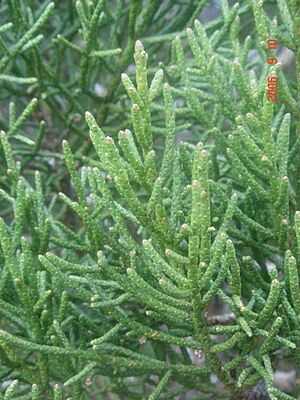Athrotaxis cupressoides facts for kids
Quick facts for kids Athrotaxis cupressoides |
|
|---|---|
 |
|
| Conservation status | |
| Scientific classification | |
| Genus: |
Athrotaxis
|
| Species: |
cupressoides
|
The pencil pine (scientific name: Athrotaxis cupressoides) is a special tree found only in Tasmania, Australia. Even though it's called a "pine," it's actually part of the cypress family. These amazing trees can live for over 1,000 years! They grow very slowly, only about 12 millimeters wider each year.
Like all trees in the Athrotaxis group, the pencil pine has single-veined leaves. These leaves are arranged in a spiral pattern. What makes the pencil pine special is that its leaves are small (2-3mm long and wide). They overlap and are pressed close to the stem, making them look like scales.
The tree produces two types of woody cones. These cones hold the seeds and mature about six months after the tree is pollinated. They usually stay on the tree for up to a year. The female cones are round with pointed scales and are about 12-15 mm across. The male cones are much smaller, only 3-5 mm across.
The name "pencil pine" comes from its shape. It's an evergreen tree that looks like a cone. It can grow up to 20 meters (about 65 feet) tall, with trunks up to 1.5 meters (about 5 feet) wide. This cone shape is easiest to see in high mountain areas. The tree's bark is light brown and feels rough. It gets more grooved as the tree gets older.
The name Athrotaxis comes from Greek words meaning "crowded arrangement." The species name cupressoides means "resembling cypress."
Contents
Where Pencil Pines Live
The pencil pine is a native tree found only in Tasmania, Australia. It mostly grows in the central and western mountain areas. You can find it between 700 and 1300 meters (about 2,300 to 4,200 feet) above sea level. These trees often grow near small mountain lakes called tarns. They also like damp places with peaty or wet, rocky soil.
You might see pencil pines in places like the Central Plateau Conservation Area and the Great Western Tiers. They also grow in Mount Field National Park and the mountains to the west, like Cradle Mountain. Some are scattered in the south of the island too.
Pencil pines are usually found in high mountain areas with open plants. They can also be the main tree in cool, wet mountain forests. In these forests, the tall trees (the canopy) are mostly pencil pines and another tree called king billy pine. Below them, in the understory, you might find myrtle beech and celery-top pine. There are also shrubs like prickly daisybush. On the ground, you can see plants like pineapple grass and alpine coral fern.
Sometimes, where pencil pines and king billy pines grow together, a new type of tree can appear. This is a hybrid tree, meaning it's a mix of the two species. It's called Athrotaxis x laxifolia.
Dangers to Pencil Pines
Pencil pines are very sensitive to fire. This is why the oldest and strongest groups of trees are found in damp areas. Big fires in places like the Walls of Jerusalem National Park and the Central Plateau Conservation Area in 1960-1961 and again in 2016 caused a lot of damage. These fires greatly reduced the number of pencil pines.
It's hard for these trees to recover from fires. This is because they don't handle fire well. Also, animals like sheep, rabbits, and native marsupials eat the young plants and leaves. This makes it even harder for the trees to grow back. Once a group of pencil pines is lost to fire, it's often gone for good. This is because the areas where they used to grow become filled with other plants that burn easily.
Scientists expect that pencil pines will only survive in the most fire-safe places. This is due to the problems with new trees growing and the increased risk of fires. The climate is also expected to become drier and warmer.
Some pencil pines also show signs of dying back. This is linked to a plant disease caused by a type of fungus-like organism called Phytophthora.
Tree Classification
The pencil pine, Athrotaxis cupressoides, used to be in a different plant family called Taxodiaceae. However, that family has now been combined with the Cupressaceae family, which is the cypress family.
Uses of Pencil Pines
Currently, the pencil pine is not used for timber. Its trunks are often twisted and not suitable for cutting into wood. However, these trees are sometimes grown and sold as ornamental plants. This means people grow them in gardens because they look nice.
See also
 In Spanish: Cedro de Tasmania liso para niños
In Spanish: Cedro de Tasmania liso para niños




